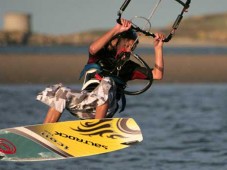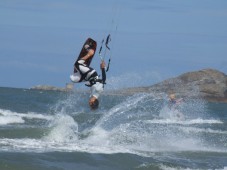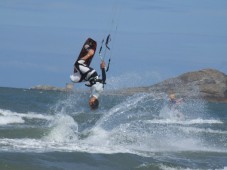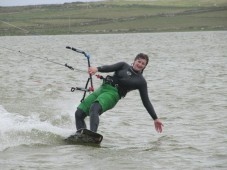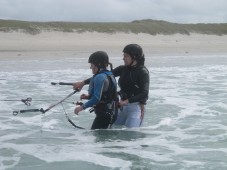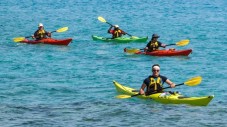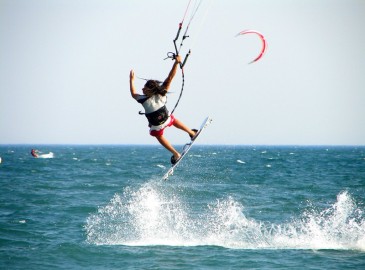
Kitesurfing in Ireland
Ride the Irish Wind and Waves!
Get ready to ride the waves and feel the wind in your hair because we're about to dive into the exhilarating world of kitesurfing in Ireland!
Kitesurfing, also known as kiteboarding, has gained immense popularity worldwide for its high-octane thrills and unique waterborne adventures. It's a sport that allows you to harness the power of the wind to propel yourself across the water, and whether you're a newbie or a seasoned kite surfer, there are vital aspects to grasp for your safety and enjoyment. From understanding the essential gear and equipment to mastering the art of launching and landing your kite, this overview of kitesurfing promises to be a fantastic starting point for your journey into this thrilling sport.
So, if you're ready to catch some waves, let's get started!
What Exactly is Kitesurfing?
Kitesurfing, or kiteboarding, is a water sport where participants are propelled across the water or land by the force of a kite, rather than the resistance of a traditional boat. Unlike a boat, the kite doesn't create resistance when it moves through the air, giving the rider a unique and exhilarating experience of gliding through the water. The most commonly used kite for kitesurfing is the windsurfing kite, although many other kites designed for water sports can be adapted for kitesurfing.
As a Lifting Mechanism: In this mode, the kite propels a boat or board above the water or land, allowing the kite surfer to soar through the air.
As a Propulsion Mechanism: The kite is connected to a boat and used to navigate through the water.
Essential Gear and Equipment
To embark on your kitesurfing adventure, you'll need a few key pieces of equipment:
Kitesurfing Sail: This component creates lift and is attached to the kite. Different types of kitesurfing sails cater to specific styles, such as free surf sails for freestyle kitesurfing and freeride sails for freeride kitesurfing.
Kite: The kite creates lift and is connected to the kitesurfing line.
Kitesurfing Board: This boat-shaped platform is used for launching and landing your kite.
Understanding the Wind Window
One of the critical aspects of kitesurfing is mastering the wind window – the range of wind in which you can effectively kite. If the wind window is too narrow, you'll have minimal wind for speed and performance. Conversely, if it's too wide, you'll face excessive wind, making control challenging.
Narrowing the wind window can be achieved by adjusting your kite control settings, altering the kite's shape and direction while kiting. Additionally, changes in your kitesurfing setup, especially when using a freestyle sail, can affect the sail's shape and rigidity. This can be accomplished by modifying the sail's angle, size, and adjusting the weight on the line and mast.
Launching and Landing Your Kite
Launching and landing your kite can be among the most challenging aspects of kitesurfing. It requires precise control over the line's tension while it's in motion across the water. This skill is honed through trial and error, with practice being key. To start, practice launching and landing your kite on the water to gain control over the line's movement. Ensure the wind window is suitable for kiting – wide enough for action but not so wide as to generate excessive power. Practicing aiming at different points in the water will help you become adept at controlling the line's trajectory.
Kitesurfing Safety
Kitesurfing offers lots of excitement for people of all ages and skill levels, but it's essential to remember that kites can be unpredictable and potentially dangerous. Safety measures are paramount:
Wear Protective Gear: Prioritize safety with a helmet and lifejacket. Even small waves can pose risks, so safeguard yourself accordingly.
Practice: As a relatively new sport, kitesurfing demands practice. The more you kite, the better you'll become.
Stay Focused: Kitesurfing requires constant attention. Avoid distractions to ensure a safe ride.
Moderate Speed: While speed is part of the thrill, high speeds can be risky. Balance exhilaration with control.
Stay in Control: The cardinal rule of kitesurfing – maintain control. Losing control often results in an unexpected plunge into the water.
Kitesurfing Tips and Tricks
Elevate your kitesurfing experience with these tips:
Choose the Right Kite: Opt for a versatile kite suitable for your skill level. Research various kite brands to find the perfect fit.
Consider a Wave-Riding Kiteboard: For enhanced wave-riding experiences, explore kiteboards designed for navigating waves. They offer better control and ride quality.
Learn the Basics of Wave Riding: Whether through online tutorials or kitesurfing courses, mastering wave riding adds an exciting dimension to your kitesurfing skills.
Developing Your Kitesurfing Skills
Kitesurfing offers a progressive learning curve, allowing beginners to start with the basics and gradually advance. Focus on key areas to maximize your kitesurfing enjoyment:
Control: Achieve mastery over your kiteboard, experimenting with different control methods to find your preference.
Riding Waves: As kitesurfing revolves around waves, understanding how to navigate them with your kite is essential.
Launching and Landing: Initially challenging, these skills are honed with practice, ensuring safe kite handling.
Kitesurfing Courses
To accelerate your kitesurfing skills and receive expert guidance, consider enrolling in kitesurfing courses. They offer a structured and safe learning environment, catering to various skill levels, from beginners to advanced enthusiasts. Whether opting for a one-day course or an intensive kitesurfing boot camp, courses provide valuable insights and hands-on experience.
Kitesurfing Locations
The beauty of kitesurfing is its accessibility; you don't need exotic locations to enjoy the thrill. Kitesurfing is possible wherever there's water – from local lakes to vast oceans and even the Great Lakes of North America. To commence your kitesurfing adventure, start at a nearby spot. Join local kitesurfing groups that host beginner-friendly sessions. For those seeking to explore more kitesurfing opportunities, online forums offer event listings and destination recommendations.
Kitesurfing Etiquette
While kitesurfing is an exhilarating pursuit, it's essential to maintain respect for safety and fellow kite surfers. Here are some tips for kitesurfing etiquette:
Wear a Lifejacket: Regardless of your skill level, a lifejacket is a must to stay afloat in unpredictable conditions.
Use a Helmet: Protect yourself from potential accidents by wearing a helmet.
Respect Rules: Adhere to local beach and water regulations to ensure safe kitesurfing experiences.
Kitesurfing in Ireland offers a thrilling and dynamic way to explore the world by harnessing the power of the wind. It's an exciting sport that provides an unmatched sense of freedom as you ride the waves, with the wind in your hair and adrenaline in your veins. Whether you're a beginner looking to master the basics or an experienced kitesurfer seeking new challenges, kitesurfing offers endless opportunities for adventure!
Kitesurfing isn't just a sport; it's a lifestyle that connects you with nature and a global community of enthusiasts. Whether you choose to kitesurf in your local waters or venture to distant shores, the excitement and camaraderie that come with this incredible sport are always within reach.
So, grab your kite, hit the water, and let the wind carry you on an unforgettable kitesurfing adventure in the stunning landscapes of Ireland and beyond. As you ride the Irish wind and waves, you'll discover that kitesurfing is not just a sport; it's a thrilling way of life that will keep you coming back for more.
We have a range of great kitesurfing experiences to choose from! Go kite surfing in Ireland today!


